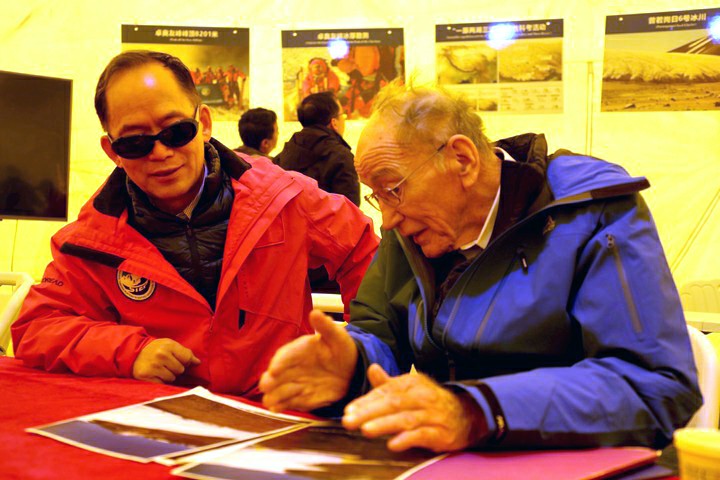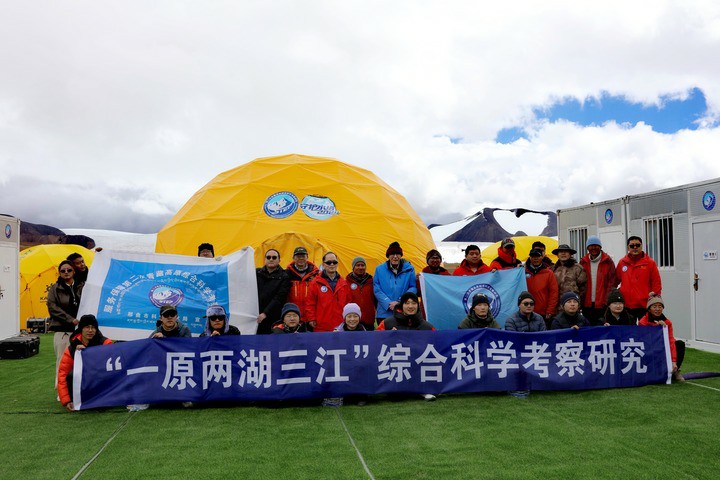Leading U.S. Glaciologist Returns to Xizang Reflecting on Remarkable Changes
A+ / A-

Yao Tandong (L, back) and Lonnie Thompson (2nd R) check ice cores drilled at a work site in Purog Kangri Glacier in southwest China's Xizang Autonomous Region, Sept. 12, 2024. (Xinhua/Jiang Fan)
Describing his relationship with Chinese scientists as "like brothers", Lonnie Thompson, a member of the American Academy of Sciences and a foreign academician of the Chinese Academy of Sciences, has returned to the highest county in China 24 years after his last visit.
In the Shuanghu County of southwest China's Xizang Autonomous Region, where the average altitude exceeds 5,000 meters, he is working with Chinese scientists to uncover the secrets of Earth.
Located roughly 90 km northeast of the county seat, the Purog Kangri Glacier stands as the largest accumulation of ice outside the polar regions. In September, Thompson and academician Yao Tandong of the Chinese Academy of Sciences arrived there to conduct the second scientific expedition on the Qinghai-Xizang Plateau. Their research primarily focused on crucial ice core drilling.
"It's really striking to go back and see these places that we drilled early in my career. I want to continue documenting the changes we observe in these glaciers." At 76 and having undergone heart transplant surgery, Thompson expressed his excitement despite facing harsh environmental conditions and physical discomfort.
This visit is part of a scientific expedition to investigate the Qinghai-Xizang Plateau, known as Asia's "water tower". The target region encompasses "one glacier, two lakes and three rivers" and is part of the second scientific expedition and research of the Qinghai-Xizang Plateau, which was initiated by China in August 2017. The goal is to understand the mechanism of environmental change and provide scientific support for the ecological security of the plateau.
The region is home to Purog Kangri Glacier, as well as Siling Lake and Namtso Lake, the largest and second-largest lakes in Xizang. It is also the birthplace of three big rivers in China, namely the Yangtze River, Nujiang River and Yarlung Zangbo River.

Lonnie Thompson (R) and Yao Tandong (L) discuss on the drilling of ice core in Purog Kangri Glacier at a camp site in southwest China's Xizang Autonomous Region, Sept. 7, 2024. (Xinhua/Liu Shiping)
Noting that this expedition is significantly in larger scale and more comprehensive, Thompson reflected on his first visit to Purog Kangri in September 2000.
"Getting here was not easy back then. The road was muddy. Because the trucks were heavily laden with gear, and then we actually had to bring a road that we could lay down in front of the truck, so they wouldn't sink in the mud," he recalled. "We worked hard to push and pull trying to just get to the site. But this year's experience is totally different. Paved road all the way here, brand-new hotel and the research base is fully equipped."
In October that year, the research team successfully drilled their first ice core, reaching a depth of 118.55 meters, followed by two additional cores at the depths of 213 meters and 154 meters.
"Ice cores are crucial for understanding climate and environmental changes. Glaciers worldwide are retreating, and once they melt, the historical records they hold will disappear. Therefore, preserving these ice cores is vital. They serve as archives, allowing us to extract historical information even as new technologies emerge," Thompson emphasized, hoping this drilling will yield the longest and oldest ice cores from mid-latitude regions.
The Purog Kangri Glacier occupies a unique position in glaciology. "The conditions of these glaciers are much different than we find in the polar regions or deeper in the tropics, and they are so important for the water resources, for the people who live downstream," he said. "Understanding what the climate history was in this region and then how it fits into the global picture is extremely important. I think the international collaboration is the only way we can do this."

Team members of the second scientific expedition on the Qinghai-Xizang Plateau pose for a group photo at the base camp in southwest China's Xizang Autonomous Region, Sept. 7, 2024. (Xinhua/Liu Shiping)
Thompson first visited China in 1984, where he began a scientific collaboration with Yao Tandong and other Chinese scholars. Over the past four decades, they have drilled ice cores in various glaciers across China and published their findings in prestigious journals like Science, while also advancing the Third Pole Environment (TPE) program.
"We have built a solid scientific foundation over our 40 years of collaboration, establishing trust and viewing each other as brothers. This relationship is our most valuable asset in scientific research and cooperation," Thompson said.
He also expressed optimism about the future of glaciology in China. He recalled that 40 years ago when he first arrived in China, there was only one glacial station, and the quality, the level of scientific research were very low. "But over the last 40 years, the investments that the Chinese governments made into glaciology have been tremendous."
"The achievements of the past 40 years in China are remarkable," he continued. "For me, the best scenario is when the world achieves a win-win situation, where we all benefit from cooperation, explore new fields, and deepen our understanding of climate science. This is how we make progress."
"China plays a very important role in the future. And I really appreciate the amount of investment the governments made in science here in China over the last 40 years. I wish I saw that in every country around the world," he concluded. "In the future, I want to continue documenting the changes we observe in these glaciers." (Xinhua)
